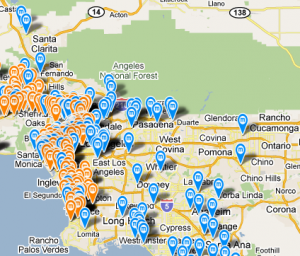
 Over the years, analytics has proven to be a pretty good business. Whether it be web analytics services like Comscore and Omniture or social media analytics services like Radian6 and Visible Technologies, companies have proven that they will pay good money for a better understanding of how people are interacting with their web site or brand online.
Over the years, analytics has proven to be a pretty good business. Whether it be web analytics services like Comscore and Omniture or social media analytics services like Radian6 and Visible Technologies, companies have proven that they will pay good money for a better understanding of how people are interacting with their web site or brand online.
But what about the real world? With the proliferation of location based services, it would seem that there is a real opportunity to better understand how people go about their daily lives. What merchants they frequent, and when. How they respond to coupons and offers. And which people are actively promoting merchants to their friends.
With the vast majority of commerce still happening offline, this information is pure gold.
Services like Foursquare are already offering SMBs and brands analytics around Foursquare checkins and engagement.
But to date, we haven’t seen any company attempt to aggregate data from across all the geosocial networks to present a more complete look at consumer, real world behavior.
Enter Momentfeed.
Momentfeed is currently crunching data from Twitter, Foursquare, Gowalla, and Facebook (with plans to pull in activity from Google Buzz, Yelp, Loopt, Scvngr, and more).
Momentfeed’s sweet spot appears to be local or national brands that have hundreds or thousands of locations.
Let’s say, for example, you run marketing for The Coffee Bean & Tea Leaf.
Using the Momentfeed dashboard, you are able to run a head to head comparison of your thousands of locations vs. those of your competitor Starbucks.
You are able to quickly see your top locations by number of check-ins, as well as those of your competitors. You can see how adjacent, competing coffee shops are performing. And you can cut this data by all of your locations, or any individual location, while filtering for each of the major geo networks: Foursquare, Facebook Places, Twitter, and Gowalla.
While this data is certainly interesting to see all in the same place, where things get a little more sophisticated is in Momentfeed’s use of a proprietary algorithm that shows engagement. By throwing out volume of check-ins, Momentfeed is able to calculate a national or regional engagement score across multiple locations for a given brand. This engagement score takes into account whether or not people are commenting or posting photos with their check-ins, or pushing their check-ins out to Twitter and Facebook. And once you have a benchmark engagement score established, you are able to measure the effectiveness of various geolocation oriented marketing campaigns. In the case of Starbucks vs. Coffee Bean & Tea Leaf, it would seem that Starbucks users are slightly more engaged, at least in Southern California where the data set resides.
It’s neat stuff.
One of the interesting, macro takeaways that I got from playing with this coffee shop data for Southern California is that Foursquare is still more than holding its own against Facebook Places, at least if you consider Starbucks and Coffee Bean locations in Socal as a proxy for the entire universe of venues. On any given day it seems as if there are 2-3X as many check-ins to these two coffee chains on Foursquare as there are on Facebook Places. Twitter and Gowalla are far behind as the preferred means to share location.
Momentfeed’s marketing strategy is to showcase fun and interesting data gleaned through its analytics platform, and distribute it through local media. For example, Momentfeed has an account that is loaded up with check-in data for all of the top nightclub data in and around Los Angeles. At any given time, or snapshot of time, you are able to rank the most popular nightclubs (or at least the ones that are most appealing to early adopters). This would seem to have great infographic potential for a weekend guide for the LA Times.
Momentfeed is off to a very good start. For them to be successful, there seem to be a couple of key success factors. For example, one network can’t win. If either Foursquare or Facebook win the check-in space outright, the value proposition of aggregating multiple networks will go away. Furthermore, the check-in gesture will need to continue growing and expanding beyond early adopters. If this doesn’t happen, Momentfeed will become nothing more than a neat tool to see where people from the industry are hanging out. And finally, Momentfeed is dependent on stable, open APIs from each of the main players.
Here are some screenshots of the service. You can sign up for a private beta HERE.





Get the TNW newsletter
Get the most important tech news in your inbox each week.





